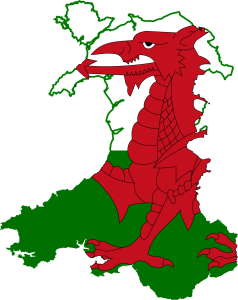Everything You Need To Know For Wales
Geographical Position And Climate Of Wales
Wales is a country that forms part of the United Kingdom and the island of Great Britain. It is bordered by England to the east, the Irish Sea to the north and west, and the Bristol Channel to the south. It has over 1,680 miles (2,700 km) of coastline and is largely mountainous with its higher peaks in the north and central areas, including Snowdon (Yr Wyddfa), its highest summit.
The climate of Wales is maritime and tends to be more moderate than the rest of the UK. It is typically characterized by wetter and milder weather due to the prevailing south-westerly winds driven by the Atlantic Ocean. Winters are usually mild with temperatures rarely dropping far below freezing, while summers tend to be warm rather than hot. Rainfall is a significant feature of the Welsh climate, with the western areas experiencing heavier rain than the east. The mountainous regions can have significant snowfall during the winter months.
Brief History Of Wales
Wales has a rich history that dates back to the Iron Age and has been inhabited by various peoples, including the Celts. The Romans arrived in the 1st century AD, leaving behind impressive fortifications. After the Roman withdrawal, Wales was divided into several kingdoms.
The Norman conquest of England in the 11th century eventually extended into Wales, leading to centuries of conflict. By the late 13th century, Edward I of England had conquered the region, building a ring of imposing castles to maintain control.
In 1536, under Henry VIII, the Act of Union joined England and Wales legally. Despite this, Welsh identity and language endured, with a revival in the 19th and 20th centuries. In 1999, Wales voted for devolution, establishing the Senedd (Welsh Parliament), which holds significant powers over Welsh affairs.
Religion Of Wales
The most practised religion in Wales is Christianity. There are Muslim, Hindu and Jewish minorities.
Language Of Wales
There are two official languages – English and Welsh.

Wales is a popular tourist destination known for its stunning landscapes, rich history, and vibrant culture. Visitors are drawn to its rugged coastlines, picturesque valleys, and towering mountains, including Snowdonia National Park, which offers some of the UK’s best hiking. Wales boasts numerous castles like Caernarfon and Conwy, testament to its medieval past.
Places You Must Visit In Wales
- Cardiff
- Swansea
- Anglesey
- Gower Peninsula
- Snowdonia National Park
- Brecon Beacons
- Conwy Castle
- Chepstow Castle
Before You Visit Wales
Travel to Wales
By Air: The main international gateway is Cardiff Airport (CWL), which has flights from various European cities. Other nearby airports include Bristol (BRS) in England and the larger hubs like London Heathrow (LHR) and Manchester (MAN), which offer a wider range of international connections.
By Train: Wales is well-connected by train, with direct services from major UK cities like London, Manchester, and Birmingham. The journey from London Paddington to Cardiff Central, for example, takes around 2 hours.
By Car: Driving to Wales offers flexibility and the chance to enjoy the scenic routes. Major motorways like the M4 and M50 lead into South Wales, while the A55 serves North Wales.
By Bus/Coach: National Express and Megabus provide coach services to various Welsh destinations from different parts of the UK, offering an economical way to travel.
By Ferry: For those coming from Ireland, there are ferry services to Wales from Dublin to Holyhead and from Rosslare to Fishguard and Pembroke Dock.
Visas for Wales
If you’re planning to visit Wales, it’s important to know that it is part of the United Kingdom, and therefore the visa requirements for the UK apply. Here are some general guidelines:
Tourist Visas: For short stays, tourists from many countries can enter the UK without a visa for up to six months. This includes citizens from the EU, USA, Canada, Australia, and New Zealand, among others.
Visa Nationals: If your country is not on the visa-exempt list, you will need to apply for a Standard Visitor Visa before traveling to the UK.
Work, Study, and Long-Term Visas: Different visas are required for those intending to work, study, or live in the UK for longer periods. These include Tier 2 visas for skilled workers, Tier 4 visas for students, and family visas, among others.
EU Citizens Post-Brexit: Since the UK has left the EU, the rules for EU citizens have changed. EU, EEA, or Swiss citizens can visit the UK for up to six months without a visa but may require one for work, study, or longer stays.
Best time to visit Wales
The best time to visit Wales depends on your interests and what you want to do during your trip:
Late Spring (May to June): This is a great time for outdoor activities. The weather is generally mild, the days are long, and the countryside is lush and green.
Summer (July to August): Expect the warmest weather and a lively atmosphere as this is peak tourist season. It’s ideal for coastal visits, festivals, and mountain hikes, but be prepared for more crowds and higher prices.
Early Autumn (September to October): With fewer tourists and still pleasant weather, early autumn is perfect for those who enjoy quiet exploration of the natural scenery and historical sites.
Winter (November to February): Winter can be cold and wet, but it offers a different experience with snow in the mountains, cozy pubs, and fewer tourists. It’s also a good time for cultural indoor activities, such as visiting museums and castles.
Remember that Welsh weather can be unpredictable, so packing waterproof clothing and layers is advisable no matter when you visit.
Important Information
Capital – Cardiff
Territory – 21,218 km2
Currency – Pound Stirling
Time zone – UTC+0 (GMT) / UTC+1 (BST)
Population – 3,105,410
Demonym – Welsh
